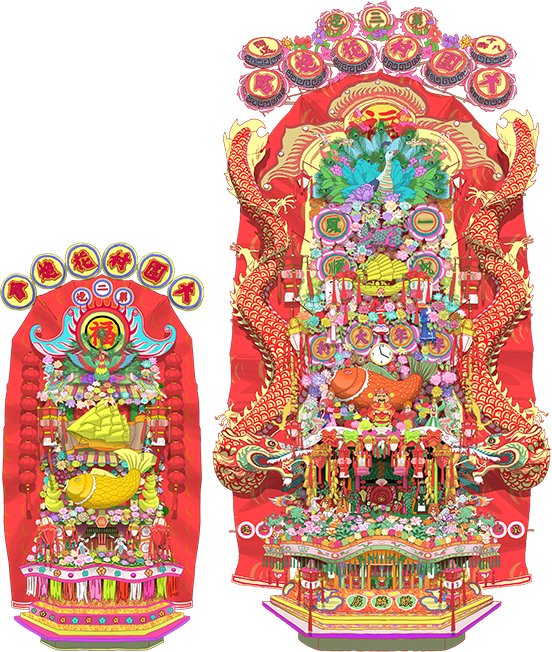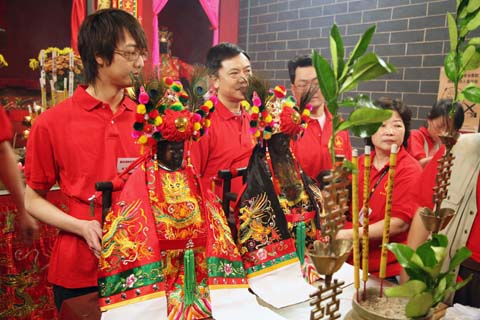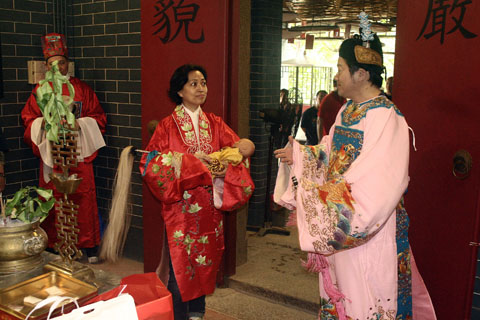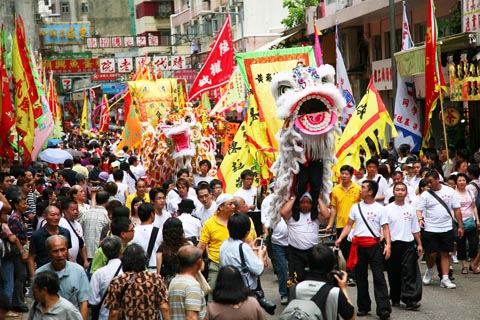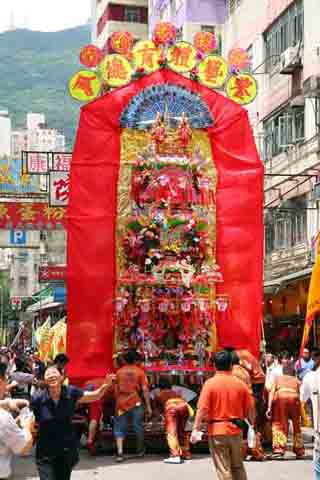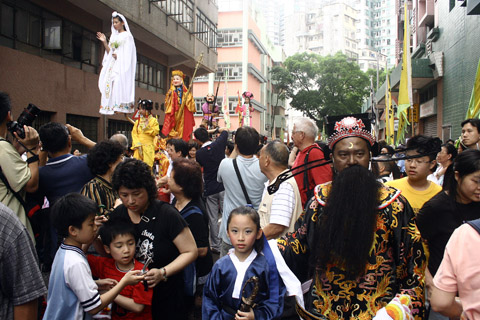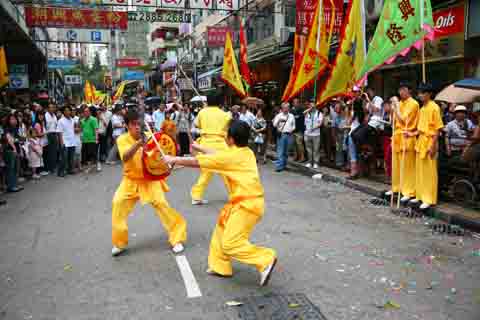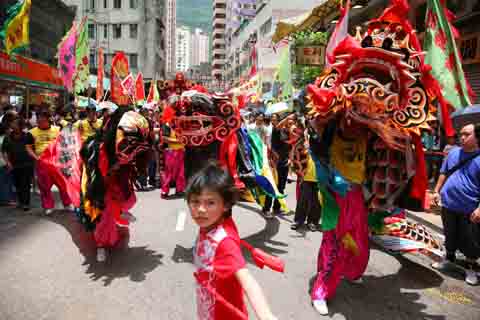In the past there was a Wong Nai Chung Village at Happy Valley. In the early years the villagers built a Tam Kung Temple at the slope near the present Hong Kong Sanatorium and Hospital. In 1901, the Hakka community of Wong Nai Chung raised funds to rebuild the temple at its present address at Blue Pool Road, and worshipped Pak Tai together with Tam Kung. The temple was named Pak Tai Tam Kung Temple – two deities enshrined in a temple. Later, a Tin Hau Temple was built at the back of the temple. All three deities were gods of water.
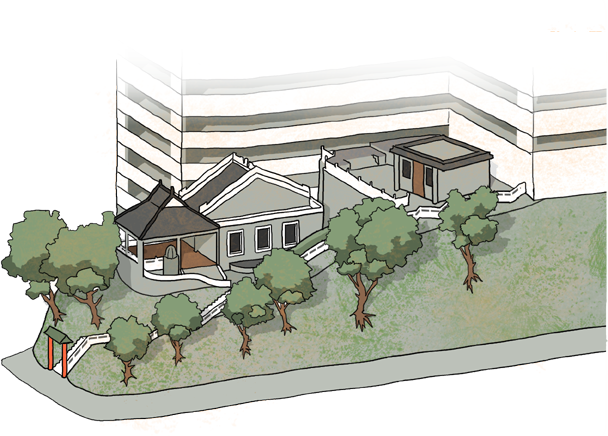
Pak Tai was named Zhenwu Heavenly Emperor of Xuan Tian of the North. He was originally one of the seven stars of the north, and was represented by Xuan Wu – a holy beast that was a combination of a turtle and a snake. Later, Pak Tai was said to be the general who was stationed in the north by the orders of the Jade Emperor, and was named “The Heavenly Emperor of Xuantian” until Song Dynasty, when the name was changed to Zhenwu Emperor to avoid overlapping with the title of imperial emperor. Because North bears the property of water in the Five elements (representative colour is black), and the inhabitants of Guangdong live beside the water, Pak Tai is a popular deity in the region, and protects the residents against water disasters.

There are numerous temples in Hong Kong that worshipped Pak Tai. Some are named Yui Hui Temples, and no special events are held on the Pak Tai Festival on 3rd of the 3rd Lunar Month, with the exception of more incense offerings from believers. However, the Pak Tai Temple at Happy Valley is rather boisterous with the Wong Nai Chung Neighbourhood Committee taking turns to organize festivities for Pak Tai and Tam Kung, and carries the deity in a parade on the eve of the festival.
Whether at Pak Tai Festival Parades or Tam Kung Festival Parades, the festival committee carries the shrines of the two deities out of the temple and places them in the same palanquin, accompanied by a boy called “the deity child”. The palanquin is carried by a number of men and parades the streets of Happy Valley led by a sea of flags. On the way Daoist priests chants invocations with believers sprinkling pomelo leave water to dispel evil and bring peace to the community.
The parade of deities reflect the “area of worship” of a temple. The parade route of deities Pak Tai and Tam Kung marks out the area of the old Wong Nai Chung Village; Sing Woo Road, where the parade crowd passes used to be a muddy river. The river split into two tributaries at the present day racecourse and rejoined at Canal Road. Later, the tributaries were filled up and became Wong Nai Chung Road, which encircles the racecourse. Now Wong Nai Chung Village is no longer on the map, and “Wong Nai Chung” has become a rarely mentioned name except at festivals.

Deity parades have a religious significance as well as helping to foster community cohesion. Even as the city develops and folk customs get less attention, the deity parades at Happy Valley, because of their huge attendance and the presence of lion dance troupes, maintained a rich festive atmosphere. In the afternoon, the believers who have donated offerings (of any amount) can use their ticket to enjoy the “god-worshipping banquet” at the Crescent Garden nearby. The festival committee passes the food offerings to a caterer who will prepare the feast. Each year, over 1,000 members of the community come to enjoy the feast or take food home.
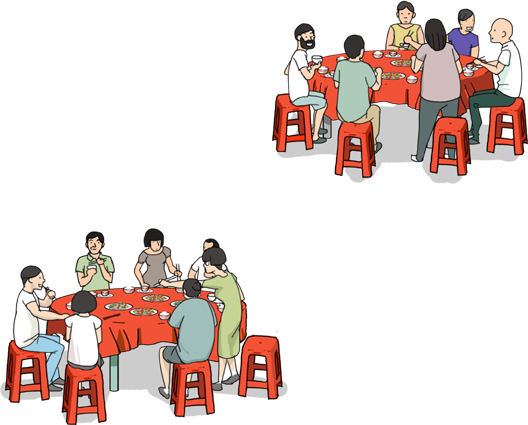
The festival committee also hires opera troupes to perform three days of god-worshipping plays which the community can freely sit in. In the afternoon of the festival, the troupe enters the temple to perform three short regular plays for the gods, including “Birthday Greetings by the Eight Immortals”, “Promotion in the Court” and “The Heavenly Maiden Offering a Son”. The festival committee members offer incense and paper ingots to each deity and believers also pay their homage. The committee removes the decorations on the palanquin to be auctioned in the banquet, and the proceedings go into event expenses.
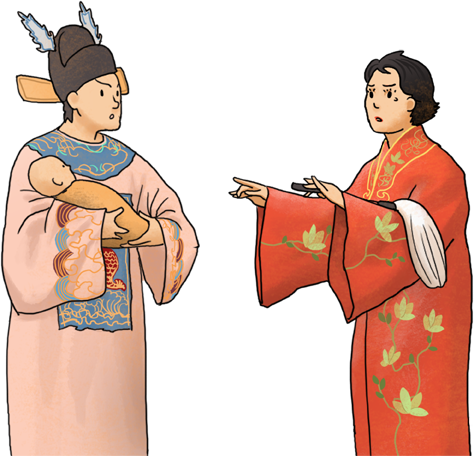
The Tin Hau Festival at Shap Pat Heung of Yuen Long comprises three events: god worshipping, parade and floral tribute lottery. On the eve of the festival, large numbers of believers come to the Tin Hau Temple at Tai Shu Ha to offer the first incense. Members of the floral tribute societies also arrive and give their best performances until mid-night. At 11pm on the eve of the festival, the village leaders and representatives of Shap Pat Heung of Yuen Long, together with floral tribute society representatives, enter the temple to pay homage to the gods. They also chant invocations in reverence of the deities.
Tin Hau Temple at Tai Shu Ha, which was built in the 18th century, is a cluster of 7 buildings. It has for a long time been the centre of community affairs, entertainment and education; it is also the most important Tin Hau Temple of Yuen Long. The carnival parade of the festival day ends at the temple, where the floral tribute lottery is also held.

The deity parade of Yuen Long was a newly emerged custom which began in 1963. Considering that serious traffic congestions were resulted from floral tribute societies bringing offerings to the Tin Hau Temple at Tai Shu Ha, the then District Officer of Yuen Long Sir David Jones conferred with the village leaders of Shap Pat Heung to arrange one parade for all floral tribute societies. This was the beginning of the Tin Hau Festival Parade. The parade attracted large numbers of on-lookers and became a noted annual event of Hong Kong.
In 2010, 4,000 participants in 30 teams join the parade, most from floral tribute societies. The parade began in Yuen Long at the minibus stop at Fung Cheung Road and the car park at Kin Tak Street, passes through Kau Yuk Road, and turns into Yuen Long stadium. The parade team stops to perform for the public in many locations. The performances include lion, dragon and kylin dance, Chiuchow dance, ethnic drum dance, and marching bands. Among them, Yuen Long Floral tribute society is rather unique in that they dress up young children of 4 or 5 years of age as farmers or farm ladies, in reminiscence of the rural life of the previous generations.

After the performances, those who participate in the floral tribute lottery pass through Ma Tin Road and Tai Shu Ha Road East to arrive at the Tin Hau Temple at Tai Shu Ha. It is after two by the time the final team arrives. In Shap Pat Heung there are 30 floral tributes, at the centre of which is a Tin Hau Statue – a de facto palace of the deities. The floral tribute societies builds a new tribute each year for the temple, which will be redistributed on the festival day. The 3rd tribute, named “riches and plentiful offspring”, is considered the most auspicious and had the most auspicious decorations. It measures 20-feet in height and is the tallest of its kind in Hong Kong. All floral tribute societies hope to bring this floral tribute home.

In the past, a floral tribute scrambling was held to decide who gets which tribute, but the scramble often resulted in conflicts. In 1949, after the founding of the Shap Pat Heung Rural Committee, all village representatives agreed to turn to lottery for the distribution of floral tributes.
After all flower tribute societies arrive at the temple, the village leaders enter the temple and use the sacred palanquin to carry the statue of Tin Hau to a pavilion outside the temple. The District Officer and District Lands Officer of Yuen Long, and the Chief Superintendent of Police officiate the floral tribute lottery ceremony. They draw the names of 30 floral tribute societies from a total of several thousand tribute tickets, and the representative of each society in turn draws the number. The society that scores the 3rd tribute receives the highest applause.

Who is Tam Kung? There are different versions of the folklore. According to the Chinese Temples Committee, Tam Kung is originally named Tam Qiao, and was born in Guishan of Huidong County in Yuan Dynasty (presently Huizhou County of Guangdong). He gained passage to the heavenly way at the age of 12, and possessed the power to call wind and rain and heal the sick, and was thus revered as a deity. His power to predict the weather won him the trust of the fisherfolk. In the past, Shau Kei Wan was a fisherfolk community, and the stonecutters from Hui and Chiu Counties also came here to quarry stone; the Tam Kung Temple built in 1905 was the place where they paid their homage.

The past Tam Kung Festivals at Shau Kei Wan featured opera and floral tribute scrambling activities. The residents organized a deity parade in 1961 during the cholera outbreak, but the festivities have diminished since. In the mid-1990s the festival saw a revival, helped along by the public holiday of Buddha’s Birthday, which allowed a growing number of the public to join the festivities. The organizers come up with new activities every year featuring different performing organizations hoping to elicit public interest and bring thriving business to the eateries in the district.
The Tam Kung Festival Parade has evolved into the largest festivity of Shau Kei Wan District. The parade is overseen by two organizers which begin their parades near Shing Wong Temple at different hours, each bearing unique features. In 2003, parade-in-the-air elements were added; in 2006 boys impersonating Tam Kung joined the parade; 2007’s parade featured artistic roller skating performances, which incorporated western elements into the Chinese festival. In 2010, on the eve of the Tam Kung Festival, the organizers organized the first “Parade on the Water” and revived the god-worshipping plays, and drove the festivities to a new height.

Every festival parade is an opportunity for martial arts or lion dance societies to showcase their specialties. They dispatch dancing lions, kylins, golden dragons and auspicious beasts to pray for the blessings of deities and to demonstrate their capabilities to the district and other societies. It was a martial arts showcase with different schools of marital arts coming together at one place.
In the Tam Kung Festival Parade, one sees certain martial arts societies performing their specialties including double or even triple shoulder stand, and lion dancing on top of a bamboo pole. Some groups even dispatch disciples to perform kung-fu or spar using weapons, turning the religious parade into a martial arts carnival.
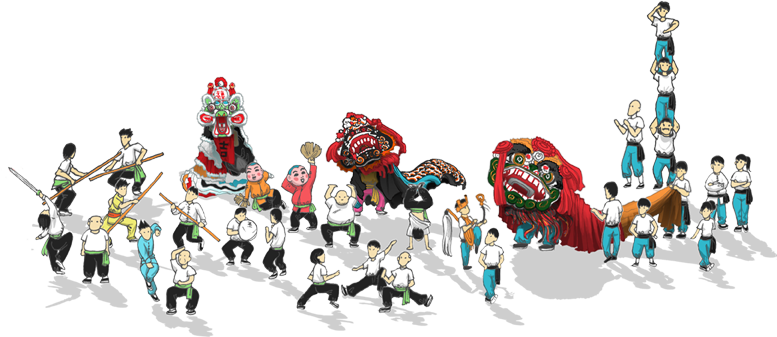
In the parade one also sees all manners of auspicious beasts. There are numerous types of southern lions, for example the red-and-black “General Kwan” lion, the black-and-white “General Zhangfei” lion, the Hakka kylin, the Hoklo golden lion, and the Nixiu. The same auspicious beast gains different interpretations between different ethnic groups and schools, and demonstrates the uniqueness of the martial arts of a region. As two auspicious beasts encounter, they meet up in a traditional ritual that involves bodily contact and mutual salutation.
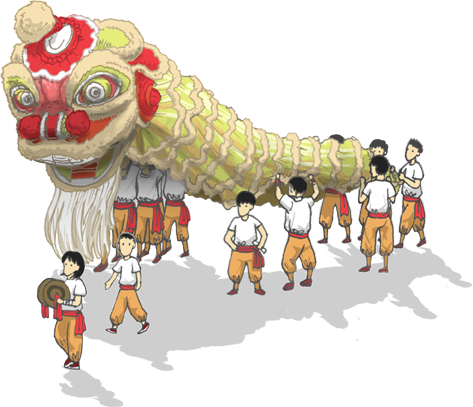
Some believers also carry their own Tam Kung shrine or large floral tributes as they offer incense at the Tam Kung Temple. They take part in the event in solemn devotion. As one enters the temple, the smoke was pervasive and many queue up to sound the drum immediately after the incense offering to alert the deities.
Shau Kei Wan is a traditional community. Each year many festivities, including numerous Yu Lan Ghost Festivals, are held here. Unlike rural villages, these district festivities are not subsidized or organized by rural committees or village offices, and all funding and arrangements depend on district individuals. Even then, the festivities are colourful and popular, allowing the folk tradition to live on.
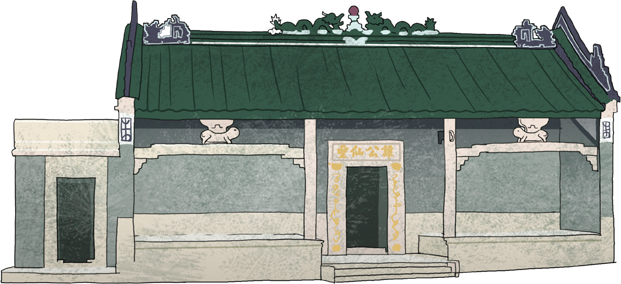
Close











